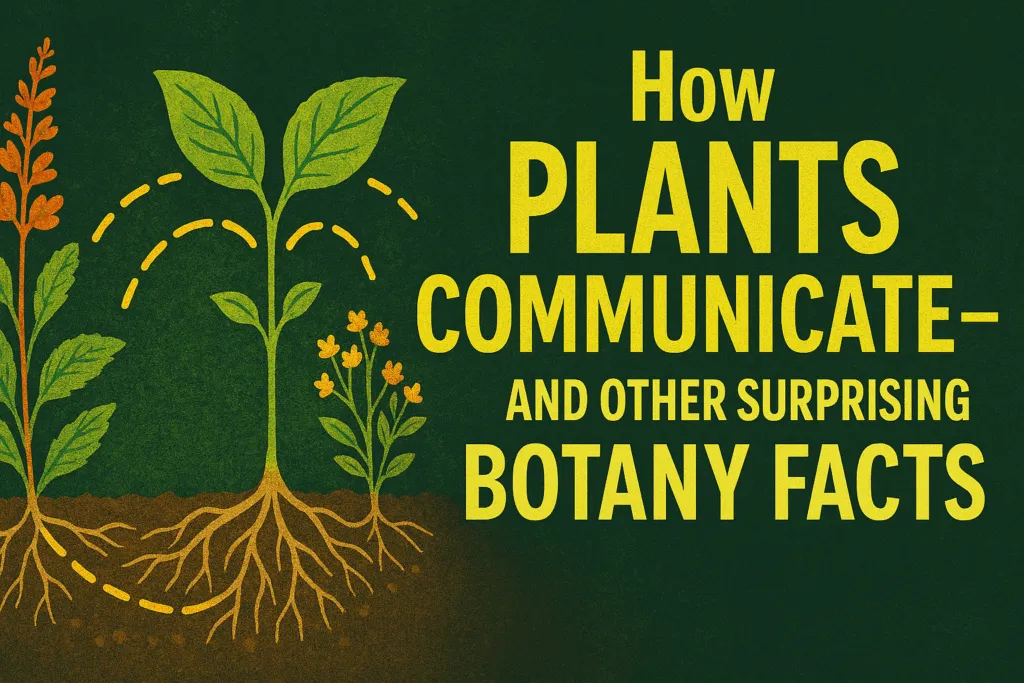Introduction: The Hidden World of Plants
When we think about communication, plants don’t usually come to mind. But the hidden world of plants is full of surprising interactions that show us just how connected they really are. Understanding how plants communicate opens up a fascinating view of nature where plants send signals, share information, and even support each other without words or sounds.
Plants have developed amazing ways to communicate with their environment and with other plants. Instead of speaking, they use chemical signals, root networks, and sometimes even vibrations to send messages. For example, when a plant faces danger from pests or harsh weather, it can release certain chemicals into the air or soil. Nearby plants detect these signals and prepare themselves for similar threats. This natural form of communication helps entire plant communities stay healthy and survive challenges.
One of the most interesting discoveries in recent years is the underground fungal network that connects plant roots. Often called the “Wood Wide Web,” this network acts like a natural internet for plants, allowing them to share nutrients, water, and information. Through these connections, plants can warn each other about attacks or support weaker neighbors by transferring resources.
The study of how plants communicate has changed our understanding of the plant world from passive organisms to active participants in their ecosystem. This hidden world shows that plants are not isolated but part of a complex, interactive system that keeps nature balanced.
Exploring how plants communicate can inspire us to appreciate the natural world in new ways and encourage more efforts to protect the environment. After all, the more we learn about plants, the more we realize how much they matter to life on Earth.
How Do Plants Talk to Each Other?
Plants may not have voices, but they have developed remarkable ways to communicate with each other. Understanding how plants communicate reveals an invisible language that helps them survive and thrive together. One of the primary methods plants use to talk is through chemical signals. When a plant is under threat, such as being eaten by insects, it releases special chemicals called volatile organic compounds into the air. Nearby plants detect these signals and activate their own defense systems, preparing themselves for possible danger.
Another way plants communicate is through their roots. Below the surface, roots send and receive messages by releasing chemicals into the soil. This helps plants share information about soil quality, water availability, or threats like harmful fungi. Even more fascinating is the role of mycorrhizal fungi, which form networks connecting different plants underground. Often called the “Wood Wide Web,” this fungal network allows plants to exchange nutrients and warnings, supporting each other in times of stress.
Plants can also respond to touch and vibrations. Some studies suggest that plants may sense the movement of nearby plants or even the buzzing of insects, which can influence their behavior. Though this type of communication is still being explored, it shows that plants are much more aware of their surroundings than we once thought.
Overall, the ways plants talk to each other may be silent and slow compared to animals, but they are effective and essential. This hidden communication system helps plants adapt to their environment and work together to survive challenges, proving that even without words, plants have a powerful way of connecting.
How Do Plants Protect Themselves?
Plants may seem peaceful, but they have clever ways to protect themselves from threats like insects, animals, and harsh weather. Understanding how plants communicate helps us see that their defense strategies often involve sending signals to other plants and even recruiting helpers from nature.
One common method plants use to protect themselves is by releasing chemical signals when attacked. For example, if a plant is being eaten by pests, it emits special chemicals into the air that warn nearby plants. These neighboring plants then activate their own defense systems, such as producing bitter or toxic substances that make them less appealing to insects. This way, plants work together as a community to stay safe.
Plants also attract natural defenders to help protect them. Some release scents that lure predatory insects like ladybugs or parasitic wasps, which feed on harmful pests. This is a smart way plants use nature’s own pest control instead of relying on their own limited defenses.
Physical barriers are another important defense. Many plants grow thorns, spines, or thick leaves that make it difficult for animals to eat them. Some plants even change the toughness or thickness of their leaves based on environmental stress, making it harder for pests to damage them.
Interestingly, plants can also “remember” past attacks and respond more quickly if the same threat returns. This ability to adapt and strengthen their defenses shows how dynamic plant protection really is.
In short, how plants communicate plays a big role in their survival. By sending warnings and calling for help, plants protect themselves and their neighbors, creating a natural balance in the ecosystem.
Can Plants Learn?
The idea that plants can learn might sound surprising, but recent research suggests they have more awareness than we once believed. While plants don’t have brains or nervous systems like animals, studies show that they can adapt their behavior based on past experiences, which is a form of learning.
Scientists have observed that plants can “remember” certain events. For example, if a plant experiences drought or pest attacks, it may adjust its responses to better handle similar situations in the future. This memory helps plants conserve resources and increase their chances of survival. In some experiments, plants exposed to repeated stimuli showed faster or stronger reactions over time, much like learning in animals.
How plants communicate also plays a part in this process. By sending chemical signals and sharing information through root networks, plants can prepare themselves and their neighbors for challenges ahead. This collective “awareness” boosts their survival as a community.
Though plants don’t learn in the traditional sense, their ability to change behavior based on experience highlights their intelligence and adaptability. It challenges our old assumptions and opens up exciting questions about what learning really means in the natural world.
So, while plants don’t sit and think like humans, they are far from passive. Their subtle form of learning through communication and adaptation reveals a hidden depth to plant life that science is only beginning to understand.
Do Plants Hear Sounds?
The question of whether plants can hear sounds might seem unusual, but recent studies suggest that plants are more sensitive to their environment than we once thought. While plants don’t have ears or a nervous system like animals, they can detect vibrations and respond to certain sounds.
Research has shown that some plants react to the vibrations caused by insect wingbeats or flowing water. These vibrations can trigger changes in the plant’s growth or defense mechanisms. For example, when plants “hear” the buzzing of harmful insects nearby, they may increase production of chemicals that deter pests or strengthen their physical defenses.
Scientists have also experimented with playing different sounds and music near plants. Some studies report that certain sound frequencies can influence seed germination, growth rates, and even flowering. While this research is still in early stages, it points to an intriguing form of plant sensitivity to sound waves.
How plants communicate doesn’t rely heavily on sound like humans or animals, but their ability to detect vibrations adds another layer to their complex interaction with the environment. This shows that plants are not completely silent or unaware; instead, they constantly “listen” in their own way to survive and thrive.
Though plants don’t hear sounds like we do, their response to vibrations challenges our understanding of plant senses and opens new possibilities for how we care for and interact with the natural world.
How Plants React to Changes Around Them
Plants live in a constantly changing environment, and their ability to respond to these changes is key to their survival. Unlike animals, plants cannot move to escape danger or seek better conditions, so they have developed unique ways to sense and react to the world around them.
One way plants respond is through growth adjustments. For example, when light is limited, plants will grow taller or bend toward the light source to maximize photosynthesis. This process, called phototropism, helps them get the energy they need to survive. Similarly, roots grow deeper or spread out in search of water and nutrients, adapting to changes in soil conditions.
Plants also react to temperature and seasonal changes by altering their life cycles. Many plants enter dormancy during cold months to conserve energy and protect themselves from frost. When conditions improve, they resume growth and reproduction. These adaptations show how sensitive plants are to environmental cues.
Stress factors such as drought, pests, or physical damage trigger internal signals in plants. Through chemical communication, plants can activate defense mechanisms or adjust metabolism to cope with stress. Nearby plants often detect these signals and prepare themselves as well, demonstrating a shared awareness in plant communities.
How plants communicate and react to changes highlights their incredible resilience. Their responses may be slow compared to animals, but they are effective strategies developed over millions of years. By understanding these natural reactions, we can better appreciate the complex ways plants interact with their environment and support life on Earth.
Famous Experiments About Plant Communication
The study of how plants communicate has a rich history filled with fascinating experiments that have changed the way we understand plant life. These experiments reveal that plants are far more interactive and responsive than we once believed.
One of the earliest and most famous experiments was conducted by botanist Jagadish Chandra Bose in the early 1900s. He used sensitive instruments to measure electrical signals in plants, showing that plants respond to stimuli like touch and injury. His work laid the foundation for understanding that plants have complex signaling systems similar to nervous responses in animals.
Another well-known study was by Monica Gagliano, who explored how plants might “learn” and “remember.” In her 2016 experiment, she showed that pea plants could associate a specific stimulus with a change in their environment, demonstrating a basic form of learning. This challenged the long-held idea that learning is exclusive to animals with brains.
Research into the “Wood Wide Web” has also provided groundbreaking insights. Scientists discovered that plants use underground fungal networks to share nutrients and information. This interconnected system allows trees and plants to support one another, especially when under stress or attack.
Other experiments have focused on chemical signaling, showing how plants release airborne chemicals to warn neighbors of danger or attract beneficial insects for protection. These findings highlight plants’ ability to communicate beyond just physical contact.
Together, these famous experiments have transformed botany from a study of static organisms to a dynamic field exploring how plants interact with their environment and each other. Understanding these discoveries deepens our respect for plants and the vital roles they play in ecosystems.
Why Plant Communication Is Important
Plant communication plays a crucial role in maintaining healthy ecosystems and supporting life on Earth. Understanding why plant communication is important helps us appreciate how plants survive, adapt, and interact with their environment and each other.
One key reason plant communication matters is that it allows plants to warn each other about threats such as pests, diseases, or harsh weather. When a plant sends chemical signals to its neighbors, it helps the entire community prepare defenses, reducing damage and increasing survival chances. This teamwork strengthens the ecosystem as a whole.
Plant communication also supports nutrient sharing through underground networks. Connected plants can share water, minerals, and nutrients, especially helping weaker or younger plants grow. This cooperation ensures diversity and resilience in forests, gardens, and natural habitats.
Beyond their own survival, plants’ communication impacts animals and humans too. Healthy plants provide oxygen, food, and shelter to countless species. When plants communicate effectively, ecosystems stay balanced and robust, supporting biodiversity.
From a practical standpoint, understanding how plants communicate can improve agriculture and gardening. Farmers and scientists can use this knowledge to develop natural pest control methods and enhance crop resilience without relying heavily on chemicals. This leads to more sustainable and eco-friendly farming.
In short, plant communication is a vital natural process that connects life beneath and above the ground. Recognizing its importance encourages us to protect plant communities and the environments they support, ensuring a healthier planet for future generations.
Conclusion: Plants Are Smarter Than You Think
Plants may not have brains or voices, but they are far smarter and more connected than we often realize. The ways plants communicate—with chemical signals, underground networks, and even responses to vibrations—reveal a hidden world where they share information, protect each other, and adapt to changing environments. This silent communication shows that plants are active participants in their ecosystems, not just passive organisms.
Understanding how plants communicate challenges our traditional views and deepens our respect for the natural world. It also highlights the importance of protecting plant communities, as their health directly impacts the balance of life on Earth. From warning neighbors about threats to supporting weaker plants through nutrient sharing, plants demonstrate remarkable intelligence and cooperation.
So next time you walk through a garden or forest, remember that plants are quietly “talking” all around you. Their smart communication systems have been honed over millions of years, proving that intelligence takes many forms—even without a brain.
Also Read: 10 Ocean Secrets Scientists Recently Discovered.
FAQs: Common Questions About Plant Communication
1. How do plants communicate without a brain or nervous system?
Plants use chemical signals, root connections, and even vibrations to send messages. These methods allow them to share information about threats, resources, and environmental changes without needing a brain.
2. What is the “Wood Wide Web” in plants?
The “Wood Wide Web” refers to the underground network of fungi that connects plant roots. Through this network, plants can exchange nutrients and information, helping each other survive.
3. Can plants warn each other about danger?
Yes, when a plant is attacked by pests or stressed, it releases chemical signals into the air or soil that nearby plants detect. These signals help neighboring plants prepare defenses against similar threats.
4. Do plants respond to sound or vibrations?
While plants don’t hear like animals, they can detect vibrations caused by insects or environmental factors. These vibrations can influence their growth or defense responses.
5. Can plants learn from experience?
Research suggests that plants can adapt their behavior based on past stimuli, showing a basic form of learning or memory to improve survival chances.
6. Why is understanding plant communication important?
Knowing how plants communicate helps us protect ecosystems, improve agriculture, and develop sustainable farming methods by leveraging natural plant behaviors.













